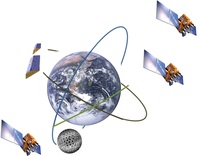 Reference
frames are the basis for the quantification of processes in the Earth's
system and thus es-sential for referencing monitored global change
parameters such as sea level change. The future re-quirements on the
reference frames in terms of accuracy, long-term stability and
reliability will necessi-tate an entirely physically based datum
definition and realisation. Dynamic satellite reference frames bear the
potential for novel concepts for datum realisation. Access to the centre
of mass can only be provided by dynamic reference frames realised by
satellite orbits. Global navigation satellite systems as well as low
Earth orbiting satellites are not yet fully exploited for retrieval of
datum parameters (that are origin, scale and orientation of the
reference frame). The improvement of orbit models is, however, a
prerequisite as deficiencies in radiation pressure modelling today
affect datum realisation and geo-detic parameter time series. The main
goal of the project is the maximum exploitation of available satellites
(different orbit heights, different inclinations, different tracking
techniques, and thus different sensitivity w.r.t. several datum
parameters) to realise a dynamic reference frame with high accuracy,
long-term stability and reliability. The main tasks are (1) Improvement
of orbit modelling for SLR and GNSS satellites (2) sensitivity analysis
of satellites / satellite constellations w.r.t. the datum parameters (3)
based on the results of the two first tasks: development of novel
concepts for geodetic datum definition of the International Terrestrial
Reference System.
Reference
frames are the basis for the quantification of processes in the Earth's
system and thus es-sential for referencing monitored global change
parameters such as sea level change. The future re-quirements on the
reference frames in terms of accuracy, long-term stability and
reliability will necessi-tate an entirely physically based datum
definition and realisation. Dynamic satellite reference frames bear the
potential for novel concepts for datum realisation. Access to the centre
of mass can only be provided by dynamic reference frames realised by
satellite orbits. Global navigation satellite systems as well as low
Earth orbiting satellites are not yet fully exploited for retrieval of
datum parameters (that are origin, scale and orientation of the
reference frame). The improvement of orbit models is, however, a
prerequisite as deficiencies in radiation pressure modelling today
affect datum realisation and geo-detic parameter time series. The main
goal of the project is the maximum exploitation of available satellites
(different orbit heights, different inclinations, different tracking
techniques, and thus different sensitivity w.r.t. several datum
parameters) to realise a dynamic reference frame with high accuracy,
long-term stability and reliability. The main tasks are (1) Improvement
of orbit modelling for SLR and GNSS satellites (2) sensitivity analysis
of satellites / satellite constellations w.r.t. the datum parameters (3)
based on the results of the two first tasks: development of novel
concepts for geodetic datum definition of the International Terrestrial
Reference System.